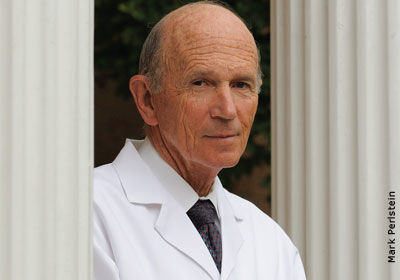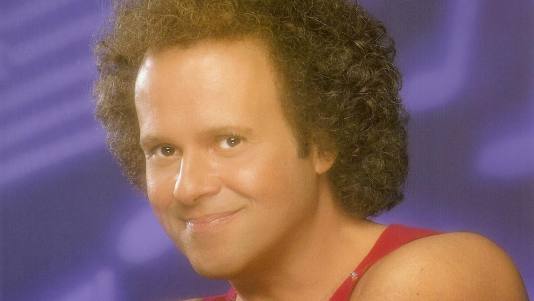By Lance Dalleck, Ph.D.
Join the conversation!
What do you think of these milestones and influential people in the history of fitness? Do you think we overlooked anyone or anything? What do you think the future of fitness holds?
As we move forward through the 21st century, one of the greatest accomplishments to be celebrated is the continuous pursuit of fitness since the beginning of man’s existence. This two-part series highlights 50 notable events, people and trends that have shaped the history of fitness from primitive man up to present-day Spinning® and Zumba® classes. In part two of the series, we highlight 25 notable events, people and trends that have shaped the history of fitness, beginning with the modern fitness movement and continuing to the present.
To read Part 1 of this series, click here.
 26. Dr. Kenneth H. Cooper (1968)
26. Dr. Kenneth H. Cooper (1968)
Dr. Kenneth H. Cooper, widely recognized as the father of the modern fitness movement, is generally credited with encouraging more individuals to exercise than any other person in history. Cooper introduced the concept of aerobic exercise and advocated a philosophy that shifted away from disease treatment to one of disease prevention. “It is easier to maintain good health through proper exercise, diet and emotional balance than it is to regain it once it is lost,” he said. His book Aerobics, released in 1968, sent a powerful message to the American people: To prevent the development of chronic diseases, one must exercise regularly and maintain a high level of fitness throughout one’s life.
27. Jazzercise (1969)
Judi Sheppard Missett founded the dance-based fitness program Jazzercise in 1969. Jazzercise consists of a one-hour group fitness class comprised of cardio, strength and stretch moves and incorporates elements of hip-hop, jazz dance, kickboxing, Pilates, resistance training and yoga for a total-body workout. In its 40-plus-year history, millions of people of all ages and fitness levels have used Jazzercise to achieve their personal fitness goals. The Jazzercise franchise continues to grow today and will undoubtedly positively influence millions of more individuals in the years ahead.
28. Jacki Sorensen (1970s)
In the early 1970s, Jackie Sorensen took the aerobics program previously developed by Dr. Kenneth Cooper, added music, and helped to create one of the most influential fitness movements in modern history—aerobic dance. More than 40 years later, Sorensen continues to produce new programs and dance-aerobics classes remain a fixture in fitness facilities worldwide.
29. Frank Shorter (1972)
In 1972, marathoner Frank Shorter captured the gold medal at the Summer Olympic Games in Munich, Germany. His victory is widely identified as the spark that ignited the running boom across America in the 1970s and continued into the 1980s. An estimated 25 million people took up running during this time period, with the popularity of road races and marathon running also increasing exponentially. For this reason, Frank Shorter is often referred to as the Father of the Running Boom.
30. Resistance Training for Fitness (1970s)Physical culture, a regimen of various strength-training exercises performed for health benefits, originated in the mid-1800s; the physical-culture movement began as more and more individuals observed that members of the middle class during that time period were suffering from diseases caused by affluence and a sedentary lifestyle. Strength training has since gone through many radical transformations and for many years was thought to be an activity exclusive to body builders, athletes and strong-men contestants. However, beginning in the mid-1970s with the publication of the first edition of
ACSM’s Guidelines for Exercise Testing and Exercise Prescription, and continuing to the present, it has become increasingly recognized that regular participation in strength training, known today as resistance training, is essential for individuals of all ages to achieve muscular fitness.
31. Richard Simmons (1970s)

Richard Simmons began his career in the fitness industry in the 1970s and has remained a fixture ever since. Following his own weight-loss experience, Simmons opened an exercise studio where eating reasonable portion sizes and performing proper exercise was emphasized. With his high-energy, motivational style, Simmons has helped countless numbers of people lose weight. In fact, it has been estimated that over the course of his fitness career, he has helped humanity lose 12 million pounds! Simmons has produced dozens of aerobic-workout videos, including the popular Sweatin’ to the Oldies series.
32. Jane Fonda (1982)
In 1982, Jane Fonda’s Workout exercise video was released; it would eventually sell 17 million copies, more than any other home exercise video. Jane Fonda produced and released numerous other workout videos throughout the ‘80s and ‘90s, which enabled millions of people to exercise within the confines of their own homes. Perhaps most important is that people have been able to pursue fitness in a comfortable environment at a level best suited to their individual needs.
33. Step Aerobics (1980s)
In the 1980s, Gin Miller found herself plagued by an overuse injury from too much high-impact exercise. She was heeding the advice of her physical therapist to step up and down on a milk crate following the injury to strengthen her legs when a revolutionary idea emerged. The stepping up and down proved to be monotonous in and of itself; however, when combined with music the activity proved to be both inspirational and a great cardio workout. For this reason, Gin Miller is largely credited with creating and popularizing step aerobics.
34. Founding of the American Council on Exercise (1985)
 The American Council of Exercise (ACE) was founded in 1985. Today, with approximately 50,000 members, ACE is the largest non-profit fitness certification, education and training organization in the world. ACE has been a trusted authority on numerous important topics within the health and fitness industry; the organization has also been a valuable resource for exercise and fitness professionals throughout both the United States and worldwide. Since its formation, ACE has continuously endeavored to promote safe and effective exercise, and protect the general public from non-scientifically validated fitness programs, products and trends.
The American Council of Exercise (ACE) was founded in 1985. Today, with approximately 50,000 members, ACE is the largest non-profit fitness certification, education and training organization in the world. ACE has been a trusted authority on numerous important topics within the health and fitness industry; the organization has also been a valuable resource for exercise and fitness professionals throughout both the United States and worldwide. Since its formation, ACE has continuously endeavored to promote safe and effective exercise, and protect the general public from non-scientifically validated fitness programs, products and trends.
35. The Paleolithic Prescription (1988)
In 1988, S. Boyd Eaton was the lead author on a book entitled The Paleolithic Prescription. The premise was simple—we are caveman living in the fast lane. In a relatively short period of time from a historical perspective, humans have been systematically displaced from a very physically active lifestyle in a natural outdoor environment to a sedentary, indoor lifestyle. Unfortunately, it was argued, our genetics remain Paleolithic and the discord between what our body expects and what it receives is at the origin of many of the ever-present chronic diseases that are pandemics in our current culture. Eaton and his colleagues suggested that the intuitive solution is to replicate the indigenous human activity pattern to the extent that this is possible and practically achievable in today’s society. Today, the concept of achieving Hunter-Gatherer Fitness (while also following a Paleolithic-style diet) is surging in popularity once again.
36. Indoor Cycling and Spinning® (1989)

The idea for a group indoor-cycling fitness class was conceived by Jonathan Goldberg (a.k.a. Johnny G) in the late 1980s. His classes, which he called Spinning, were typically characterized by intermittent bouts of vigorous-intensity exercise performed with music in the background; however, group instructors could also easily modify exercise intensity to best suit client capabilities. Goldberg opened his first Spinning Studio in 1989, launching a popular fitness trend that continues to be enjoyed by millions of fitness enthusiasts.
37. The Personal Trainer (1980s)
As the prevalence of obesity, type 2 diabetes and metabolic syndrome continued to rise over the past 25 years, a new combatant entered the arena to do battle with these epidemics: the personal trainer. Undoubtedly, there have been numerous individuals throughout the course of history who have played a remarkably similar role to the personal trainer; however, it is only in the last quarter century that personal training has risen into the ranks of a recognized professional. Organizations such as ACE, ACSM and NSCA provide professional certifications and continuing education for personal trainers to better prepare them as our first line of defense against chronic diseases.
38. Steven Blair (1980s)
As obesity rates skyrocketed in recent decades, countless weight-loss programs (both legitimate and non-legitimate alike) were developed and implemented to counter this expanding epidemic. According to some, including renowned exercise physiologist Steven Blair, this obsession with weight loss has detracted from the more important health benefits of being fit. Blair has devoted his entire career to exploring the benefits of high levels of cardiorespiratory fitness. A quarter century of research findings has resulted in a simple message: It is better to be fit and fat rather than unfit and lean. For this reason, many argue that cardiorespiratory fitness is the ultimate health outcome.
39. Launch of SilverSneakers (1992)
Research shows that seniors tend to be the most physically inactive segment of the population. In 1992, recognizing that fitness opportunities for seniors were limited, and also motivated by her own father’s successful recovery from a heart attack through regular exercise, Mary Swanson founded SilverSneakers. The program endeavored to create a socially supportive atmosphere where older adults could participate in exclusively designed aerobic, resistance, balance and flexibility training. Twenty years later, SilverSneakers is currently the largest fitness program in the United States for older adults, with offerings at nearly 10,000 locations throughout all 50 states.
40. The World Wide Web (1990s)While the origins of the Internet date as far back as the 1950s, the public World Wide Web became fully operational during the early 1990s. Today, time spent online, whether for work or pleasure, dominates the waking hours of many individuals. In fact, it has been reported that the average American spends almost the equivalent of a full work week (40 hours) online. Unfortunately, it is also becoming increasing clear that spending too much time sitting has negative public-health implications; recent studies show a significant relationship exists between daily sitting time and risk of obesity, metabolic syndrome, type 2 diabetes and cardiovascular disease.
41. Tae Bo (1990s)In the 1990s, a new cardioboxing aerobic exercise routine known as Tae Bo, developed by Billy Blanks two decades earlier, gained immense popularity in fitness centers across the country. Tae Bo is a combination of dance, martial arts and boxing moves designed to improve cardiorespiratory and muscle fitness. Since then, an estimated 1.5 million Tae Bo DVDs have been sold, and countless iterations of cardioboxing classes were created and taught in health facilities and studios around the world.
42. Pilates (1990s)
 Pilates is a system of exercises designed to improve core strength and stability, flexibility and posture. Originally developed by Joseph Pilates in Germany during the early 20th century, the six Pilates principles are centering, control, flow, breath, precision and concentration. Because Pilates exercises can be easily adapted to a variety of populations, this form of fitness has gained immense popularity over the last 20 years. It has been reported that more than 11 million individuals in the United States regularly practice Pilates for its varied fitness benefits.
Pilates is a system of exercises designed to improve core strength and stability, flexibility and posture. Originally developed by Joseph Pilates in Germany during the early 20th century, the six Pilates principles are centering, control, flow, breath, precision and concentration. Because Pilates exercises can be easily adapted to a variety of populations, this form of fitness has gained immense popularity over the last 20 years. It has been reported that more than 11 million individuals in the United States regularly practice Pilates for its varied fitness benefits.
43. Curves (1992)
Diane and Gary Heavin opened the first Curves in Harlingen, Texas, in 1992. Curves offered fitness and weight-loss programs explicitly designed for women—a complete 30-minute workout combining cardiovascular and resistance-training exercise coupled with a scientifically validated diet program. The Heavin’s concept would quickly result in the world’s largest fitness franchise. Today, Curves has nearly 10,000 locations in 85 countries and boasts more than 4 million members.
44. Swiss (Stability) Ball (1990s)
The Swiss Ball was developed by an Italian plastics manufacturer, Aquilino Casani, in 1963. Originally, Swiss Balls (or stability balls) were primarily used by physiotherapists for various therapeutic applications, including programs for infants and those with orthopaedic problems. Over the past 30 years, stability balls have gradually transitioned from the clinical environment to the mainstream fitness setting. Today, it is almost impossible to imagine a fitness facility without several stability balls lingering in the corner. Regularly used by men and women, young and old, fit and unfit, stability balls are frequently incorporated into yoga, Pilates, balance training, core exercises and various other programs.
45. The Surgeon General’s Report on Physical Activity and Health (1996)
This landmark paper, released by the United States Surgeon General in 1996, was compiled following the most comprehensive review to date of research findings concerning physical activity and health. It was the first report on physical activity made by the Surgeon General, and its primary goal was to spark a fitness movement across the country and decrease the prevalence of physical inactivity. The physical-activity recommendation message was clear and concise—all Americans could obtain significant health benefits by including a moderate amount of physical activity for 30 minutes on most, if not all, days of the week.
46. Zumba (1999)

Zumba was unintentionally created during the 1990s in Columbia by Albert ‘Beto’ Perez when he inadvertently forgot the aerobics music for a class. Perez quickly grabbed the only other music he could find in his car—traditional Latin salsa—and a new fitness movement was born. Perez brought his dance-fitness program, with elements of hip-hop, salsa, martial arts and calisthenics, to the United States in 1999 and it has continued to grow in popularity ever since. Today, an estimated 12 million people of all shapes and sizes participate in Zumba classes on a weekly basis.
47. Functional Training (21st century)
Exercise-training programs designed to mimic tasks or activities that occur in a person’s daily life are described as functional training. While the exact origin of functional training is unclear, certain aspects of functional training have been used for years by physical therapists in their design of rehabilitation programs. In the past decade, hundreds of functional-training programs have been established, including ones targeting older adults, children, athletes, pregnant women and many more populations. Today, functional training continues to appear on annual fitness-trend lists and shows no sign of waning in popularity.
48. Launch of the "Exercise is Medicine" Initiative (2007)
In 2007, leaders from the American College of Sports Medicine and American Medical Association launched a joint initiative called Exercise is Medicine. The primary goal of Exercise is Medicine is for exercise and physical activity to become a central tenet of disease prevention and medical treatment. The initiative calls for healthcare providers to assess and review patient physical-activity levels at every office visit. For those individuals who don’t meet current physical-activity guidelines, medical professionals are encouraged to refer these patients to qualified fitness professionals who can subsequently develop a safe and effective exercise program.
49. Physical Activity Guidelines for Americans (2008)
Released in 2008, the Physical Activity Guidelines for Americans was the first-ever publication of national guidelines for physical activity. These scientifically based guidelines support the physical-activity objectives for Healthy People 2020, a government initiative launched in 2010 to improve the health and well-being of all Americans. The initiative aims to reduce the proportion of adults who engage in no leisure-time physical activity, and increase the proportion of adolescents and adults who meet current federal physical-activity guidelines for aerobic physical activity (at least moderate intensity for at least 150 minutes/week, or 75 minutes/week of vigorous intensity, or an equivalent combination) and for muscle-strengthening activity.
50. You (Present)
If you are reading this article, chances are quite good that, regardless of your specific role in the fitness industry, you are committed to the lifelong pursuit of fitness. This series has detailed the history of fitness, from ancient civilization to the present day, but you represent its future. Consider the following quote: “To the world you may be one person, but to one person you may be the world.” To every individual you help motivate to start exercising for the first time or make a simple modification to an existing program or introduce to a new invigorating routine, you are the fitness world.
________________________________________________________________________

Lance C. Dalleck, Ph.D., is academic coordinator of the Cardiac Rehabilitation postgraduate program at the University of Auckland in New Zealand. His research interests include improving exercise performance and health outcomes through evidence-based practice, quantifying the energy expenditure of outdoor and non-traditional types of physical activity, and studying historical perspectives in health, fitness and exercise physiology.